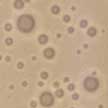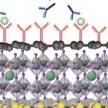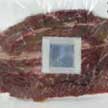Showing Spotlights 57 - 64 of 240 in category All (newest first):
 Researchers report an integrated multimodal flexible sensor system comprising a room humidity sensor, a leaf humidity sensor, an optical sensor, and a temperature sensor that can tap into potential physiological health issues of plants. Using stacked ZIS nanosheets as the kernel sensing media, the flexible sensor can not only perceive light illumination at a fast response, but also monitor the humidity with a perdurable steady performance. The researchers measured in real time three primary abiotic stresses - i.e. humidity, light and temperature - that govern the transpiration of plants are measured without signal cross-coupling effect.
Researchers report an integrated multimodal flexible sensor system comprising a room humidity sensor, a leaf humidity sensor, an optical sensor, and a temperature sensor that can tap into potential physiological health issues of plants. Using stacked ZIS nanosheets as the kernel sensing media, the flexible sensor can not only perceive light illumination at a fast response, but also monitor the humidity with a perdurable steady performance. The researchers measured in real time three primary abiotic stresses - i.e. humidity, light and temperature - that govern the transpiration of plants are measured without signal cross-coupling effect.
Aug 12th, 2020
 Conventional optothermal microbubble assisted bio-sensing is not suitable for protein sensing due to the high temperatures over 100 dgrees C. To overcome this problem, researchers have demonstrated a proof-of-concept study that reduces the working temperature of bubble generation simply by introducing a volatile, water-immiscible liquid into an aqueous medium. This enables the generation of bubbles at a much lower temperature of around 30 degrees C, not only making this sensing platform compatible with proteins but also enhancing the surface capture of proteins.
Conventional optothermal microbubble assisted bio-sensing is not suitable for protein sensing due to the high temperatures over 100 dgrees C. To overcome this problem, researchers have demonstrated a proof-of-concept study that reduces the working temperature of bubble generation simply by introducing a volatile, water-immiscible liquid into an aqueous medium. This enables the generation of bubbles at a much lower temperature of around 30 degrees C, not only making this sensing platform compatible with proteins but also enhancing the surface capture of proteins.
Jul 27th, 2020
 Researchers have turned to M13 bacteriophages as a sensing layer for colorimetric sensors. M13 is a nanoscale, benign virus with a shape that closely resembles collagen fibers. It can change its structure by shrinking or expanding in response to a changing surrounding environment. By using a highly lossy resonant promoter as the substrate, the spin-coated M-13 virus layer exhibits strong resonance even with ultrathin thickness variations, resulting in colorimetric behavior with enhanced chromaticity.
Researchers have turned to M13 bacteriophages as a sensing layer for colorimetric sensors. M13 is a nanoscale, benign virus with a shape that closely resembles collagen fibers. It can change its structure by shrinking or expanding in response to a changing surrounding environment. By using a highly lossy resonant promoter as the substrate, the spin-coated M-13 virus layer exhibits strong resonance even with ultrathin thickness variations, resulting in colorimetric behavior with enhanced chromaticity.
Jul 24th, 2020
 Researchers have designed and fabricated an ultrasensitive plasmonic biosensor with the integration of atomically thin perovskite nanomaterials on metasurfaces. For that purpose, they used an atomically thin perovskite nanomaterial with high absorption rate, sandwiched between hexagonal boron nitride and graphene layers, which enables the precise tuning of the depth of the plasmonic resonance dip. This biosensor can reach an ultra-high plasmonic sensitivity for detecting small-molecule, low-concentration analytes.
Researchers have designed and fabricated an ultrasensitive plasmonic biosensor with the integration of atomically thin perovskite nanomaterials on metasurfaces. For that purpose, they used an atomically thin perovskite nanomaterial with high absorption rate, sandwiched between hexagonal boron nitride and graphene layers, which enables the precise tuning of the depth of the plasmonic resonance dip. This biosensor can reach an ultra-high plasmonic sensitivity for detecting small-molecule, low-concentration analytes.
Jul 10th, 2020
 Many biological systems transmit signals via ions or molecules, whereas man-made sensors are mainly based on electron transport systems, i.e. electronics. The concept of ionic sensory systems is inspired by ion transport in biological systems, which is the movement of ions across a membrane, passively through ion channels or actively through ion pumps. Although sensory systems based on accurate ion transport are still in their early development, recent progress in nano-ionic sensory systems underlines their significant potential.
Many biological systems transmit signals via ions or molecules, whereas man-made sensors are mainly based on electron transport systems, i.e. electronics. The concept of ionic sensory systems is inspired by ion transport in biological systems, which is the movement of ions across a membrane, passively through ion channels or actively through ion pumps. Although sensory systems based on accurate ion transport are still in their early development, recent progress in nano-ionic sensory systems underlines their significant potential.
Jun 16th, 2020
 The structure of individual molecules and their properties, such as chirality, are difficult to monitor in real time. It turns out that temporarily bridging molecules together can provide a lens into their dynamics. Scientists now have exposed new pathways for investigating biochemical reactions at the nanoscale. They found that optoplasmonic coupling allows for the detection of biomolecules that approach nanoparticles, while they attach, detach, and interact in a variety of ways. The technique paves the way for many future single-molecule analysis techniques that researchers have only been dreaming about.
The structure of individual molecules and their properties, such as chirality, are difficult to monitor in real time. It turns out that temporarily bridging molecules together can provide a lens into their dynamics. Scientists now have exposed new pathways for investigating biochemical reactions at the nanoscale. They found that optoplasmonic coupling allows for the detection of biomolecules that approach nanoparticles, while they attach, detach, and interact in a variety of ways. The technique paves the way for many future single-molecule analysis techniques that researchers have only been dreaming about.
May 6th, 2020
 Inspired by living organisms, researchers have developed a somatosensory light-driven robot (SLiR) that can simultaneously sense strain and temperature. The SLiR subsumes pyro/piezoelectric responses and piezoresistive strain sensation under a photoactuator transducer, enabling simultaneous yet non-interfering perception of its body temperature and actuation deformation states. This design confers soft robots with complex perceptions of their body status, as well as the surrounding environments.
Inspired by living organisms, researchers have developed a somatosensory light-driven robot (SLiR) that can simultaneously sense strain and temperature. The SLiR subsumes pyro/piezoelectric responses and piezoresistive strain sensation under a photoactuator transducer, enabling simultaneous yet non-interfering perception of its body temperature and actuation deformation states. This design confers soft robots with complex perceptions of their body status, as well as the surrounding environments.
Apr 28th, 2020
 Researchers fabricated an innovative type of time-temperature sensor that can be used to detect and record temperature changes throughout the entire cold-supply chain. This nanofiber-based sensor only requires a single self-healing material with one phase, and functions as a result of its own intrinsic characteristics. Moreover, it is highly flexible, not at risk of chemical leakage, and cost-effective. Compared to electronic devices, the type of stimuli-responsive materials used in this device is cost-effective and simply to manufacture.
Researchers fabricated an innovative type of time-temperature sensor that can be used to detect and record temperature changes throughout the entire cold-supply chain. This nanofiber-based sensor only requires a single self-healing material with one phase, and functions as a result of its own intrinsic characteristics. Moreover, it is highly flexible, not at risk of chemical leakage, and cost-effective. Compared to electronic devices, the type of stimuli-responsive materials used in this device is cost-effective and simply to manufacture.
Mar 23rd, 2020
 Researchers report an integrated multimodal flexible sensor system comprising a room humidity sensor, a leaf humidity sensor, an optical sensor, and a temperature sensor that can tap into potential physiological health issues of plants. Using stacked ZIS nanosheets as the kernel sensing media, the flexible sensor can not only perceive light illumination at a fast response, but also monitor the humidity with a perdurable steady performance. The researchers measured in real time three primary abiotic stresses - i.e. humidity, light and temperature - that govern the transpiration of plants are measured without signal cross-coupling effect.
Researchers report an integrated multimodal flexible sensor system comprising a room humidity sensor, a leaf humidity sensor, an optical sensor, and a temperature sensor that can tap into potential physiological health issues of plants. Using stacked ZIS nanosheets as the kernel sensing media, the flexible sensor can not only perceive light illumination at a fast response, but also monitor the humidity with a perdurable steady performance. The researchers measured in real time three primary abiotic stresses - i.e. humidity, light and temperature - that govern the transpiration of plants are measured without signal cross-coupling effect.
 Subscribe to our Nanotechnology Spotlight feed
Subscribe to our Nanotechnology Spotlight feed





